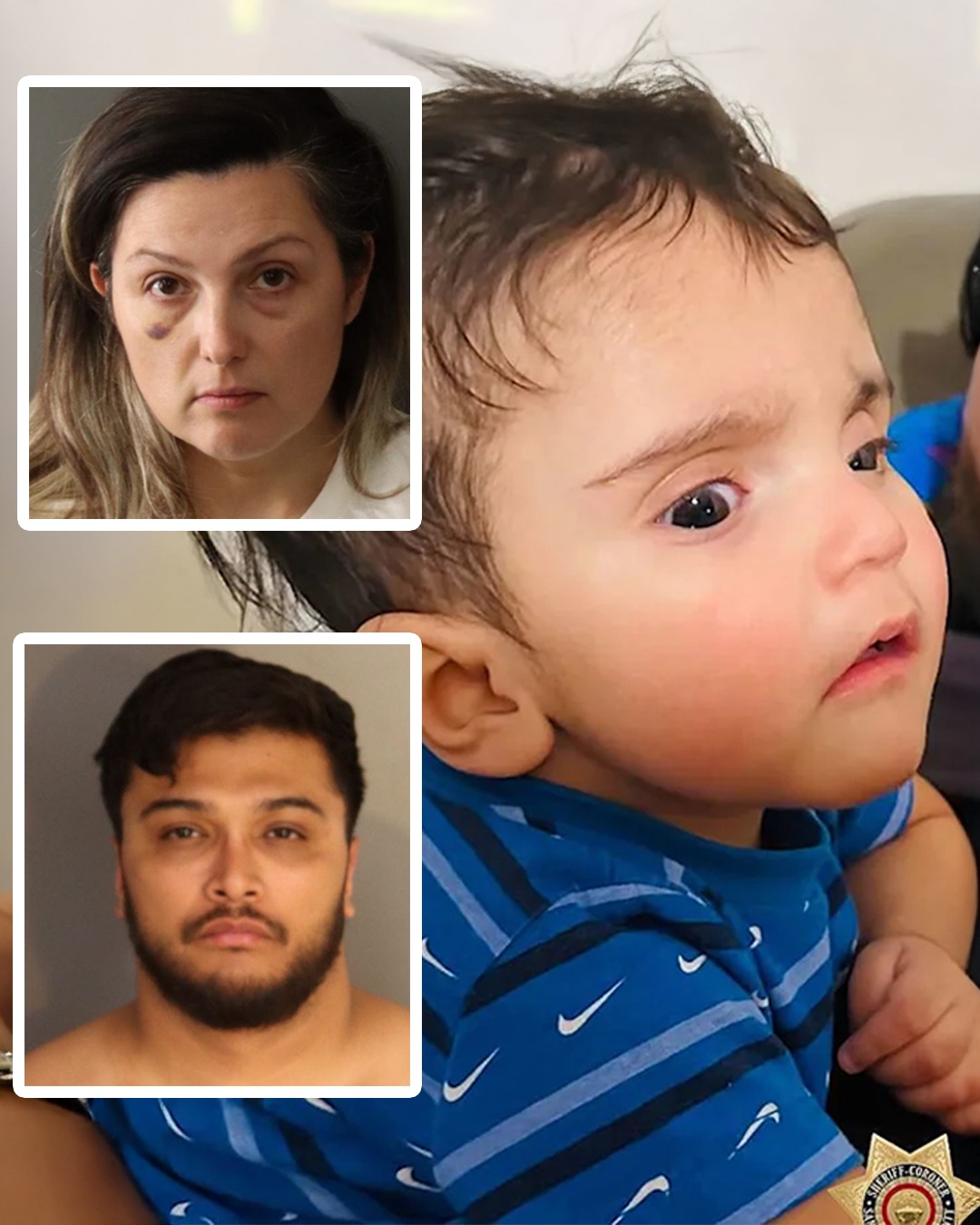In the quiet city of Yucaipa, California, a tragedy unfolded that has left the community reeling and raised profound questions about trust, innocence, and the darkest corners of human behavior. Seven-month-old Emmanuel Haro vanished from his home under circumstances that initially appeared terrifying and alarming. According to his parents, Rebecca and Jake Haro, the infant had been abducted in what they described as a sudden ambush. Rebecca, his mother, claimed that she had been knocked unconscious while changing Emmanuel’s diaper, and by the time she regained consciousness, her child was gone.
The story, at first, elicited sympathy from neighbors, friends, and even the broader public. The idea that a young infant could be taken in an instant from his own home is horrifying on its own, sparking fears about child abductions, home invasions, and the vulnerability of families. Local authorities immediately launched a search for Emmanuel, treating the case with the urgency such a situation demanded. Streets were combed, tips were investigated, and Amber Alerts were issued, all in an effort to locate the missing child and return him safely to his family.
However, as the investigation unfolded, cracks began to appear in the narrative presented by Emmanuel’s parents. Law enforcement officials discovered evidence that raised serious questions about what had truly happened inside the Haro household. Blood was found within the home, in areas that did not correspond with the story of a simple abduction during a diaper change. Investigators noted the absence of key items that one would expect to remain in a family home—a baby’s clothes and photographs, items that are often irreplaceable and central to the lives of parents and children alike.
Digital devices, which often serve as silent witnesses to events, further complicated the Haros’ story. Texts, call logs, and other data suggested inconsistencies in the timeline and details that the parents had provided. Law enforcement officials, trained to recognize deception, noted discrepancies between what the couple reported and what the digital evidence suggested. Every question that authorities posed seemed to highlight further contradictions, adding to the suspicion that the infant’s disappearance was not the result of an external abduction.
As the investigation progressed, the behavior of Rebecca and Jake Haro drew increasing attention. Witnesses described their demeanor as unusual, often lacking the emotional responses typically associated with a parent searching frantically for a missing child. Their interactions with neighbors and law enforcement, once cooperative, became more strained and guarded. The cumulative weight of physical evidence, digital data, and behavioral observations led investigators to a grim and unsettling conclusion: the infant’s disappearance may not have been caused by an outside intruder but rather by the very people entrusted with his care.
Eventually, law enforcement moved forward with arrests. Both Rebecca and Jake Haro were charged with the murder of their seven-month-old son, Emmanuel. The charges marked a shocking escalation from a story of potential abduction to a narrative of domestic violence and filicide—an act that is among the most heartbreaking and incomprehensible crimes a society can confront. Despite extensive searches, Emmanuel’s body has not yet been recovered, adding an additional layer of anguish to the case. For the authorities, the absence of the child’s remains complicates both the investigation and the grieving process for the community, leaving unanswered questions about the circumstances of his death and the motives behind it.
The community response has been one of shock, sorrow, and deep concern. Yucaipa, a city known for its small-town atmosphere and strong community ties, has been forced to grapple with the fact that a tragedy of this magnitude could occur so close to home. Neighbors have organized vigils, shared messages of support for the search and investigation, and expressed outrage over the alleged involvement of the parents. Local officials have spoken about the importance of vigilance, support for child welfare, and the urgent need for public awareness in cases of potential domestic harm.
For child welfare advocates, the Emmanuel Haro case underscores critical issues about detection, intervention, and prevention. While authorities have systems in place to respond to reports of missing children, domestic filicide presents unique challenges. The very individuals who should be safeguarding the child may pose the greatest risk, making early warning signs, background checks, and community vigilance essential. The Haro case has sparked renewed discussions on how society can better protect its most vulnerable members, and how patterns of abuse, neglect, or dangerous behavior within families can be identified before tragedy occurs.
Psychologists and criminologists examining the case highlight the complexity of filicide and parental violence. While every instance is unique, research indicates that factors such as mental health issues, extreme stress, interpersonal conflicts, and unresolved trauma can contribute to the risk of a parent harming a child. In cases like Emmanuel’s, where the details are still emerging, it is too early to draw definitive conclusions, yet the broader pattern raises urgent questions about support systems for families, monitoring, and intervention strategies that could prevent similar tragedies.
Media coverage has been extensive, emphasizing both the horror of the alleged crime and the larger societal implications. Images of a missing infant, the home where he vanished, and concerned neighbors have circulated widely, provoking empathy, outrage, and fear. The story has resonated nationally because it touches on a primal vulnerability: the safety of a child within their own family. It reminds the public that even in seemingly ordinary households, danger can exist, and that protective systems—both informal and formal—must be vigilant.
For law enforcement, the ongoing investigation involves not only gathering evidence against the parents but also searching for Emmanuel. The absence of the child’s remains complicates the case legally and emotionally, delaying closure for both the authorities and the community. Searches of nearby areas, riverbanks, and remote locations continue, guided by tips, forensic evidence, and digital records. Every day without a resolution adds to the heartbreak and underscores the urgency of resolving the case, both for justice and for the possibility of finding Emmanuel, even after death.
As the story continues to unfold, it is clear that the Emmanuel Haro case will leave a lasting impact. It serves as a sobering reminder that even within the confines of a home—a place associated with safety and nurturing—tragedy can strike. It highlights the critical importance of awareness, community engagement, and robust child protection measures. And it forces society to confront difficult questions about parental responsibility, trust, and the unseen struggles that may lie behind closed doors.
Ultimately, Emmanuel’s story is one of profound loss and unanswered questions. A seven-month-old child, full of potential, gone under circumstances that remain murky and tragic. His absence is felt not only by his parents, regardless of their involvement, but by neighbors, friends, and a community left to grapple with grief and confusion. The ongoing investigation may eventually provide answers, but the sadness of a life so young ended too soon cannot be fully measured.
In remembering Emmanuel Haro, it is impossible not to feel both sorrow and a call to action. His case demands vigilance, empathy, and renewed commitment to protecting children everywhere. It is a reminder that the safety of the most vulnerable depends not only on the systems in place but also on the awareness and engagement of those around them. Emmanuel’s life, though brief, leaves a legacy that urges society to act, to question, and to ensure that no child’s disappearance is taken lightly.
As the Haro case continues to unfold, the nation watches, hearts heavy, hoping for answers, justice, and perhaps some measure of closure. Emmanuel Haro’s story is a tragic testament to the fragility of life, the importance of vigilance, and the enduring need for compassion, awareness, and action in protecting children from harm—even from those entrusted with their care.

